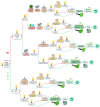Virus-Induced Genome Editing (VIGE): One Step Away from an Agricultural Revolution
- PMID: 40429744
- PMCID: PMC12111327
- DOI: 10.3390/ijms26104599
Virus-Induced Genome Editing (VIGE): One Step Away from an Agricultural Revolution
Abstract
There is currently a worldwide trend towards deregulating the use of genome-edited plants. Virus-induced genome editing (VIGE) is a novel technique that utilizes viral vectors to transiently deliver clustered regularly interspaced short palindromic repeat (CRISPR) components into plant cells. It potentially allows us to obtain transgene-free events in any plant species in a single generation without in vitro tissue culture. This technology has great potential for agriculture and is already being applied to more than 14 plant species using more than 20 viruses. The main limitations of VIGE include insufficient vector capacity, unstable expression of CRISPR-associated (Cas) protein, plant immune reaction, host specificity, and reduced viral activity in meristem. Various solutions to these problems have been proposed, such as fusion of mobile elements, RNAi suppressors, novel miniature Cas proteins, and seed-borne viruses, but the final goal has not yet been achieved. In this review, the mechanism underlying the ability of different classes of plant viruses to transiently edit genomes is explained. It not only focuses on the latest achievements in virus-induced editing of crops but also provides suggestions for improving the technology. This review may serve as a source of new ideas for those planning to develop new approaches in VIGE.
Keywords: CRISPR/Cas; RNA-dependent RNA polymerase; genome editing; transgene-free technologies; viral vector; virus-induced genome editing.
Conflict of interest statement
The author declares no conflicts of interest.
Figures


Similar articles
-
Considerations in engineering viral vectors for genome editing in plants.Virology. 2024 Jan;589:109922. doi: 10.1016/j.virol.2023.109922. Epub 2023 Oct 30. Virology. 2024. PMID: 37924727
-
Virus-Induced Gene Editing and Its Applications in Plants.Int J Mol Sci. 2022 Sep 6;23(18):10202. doi: 10.3390/ijms231810202. Int J Mol Sci. 2022. PMID: 36142116 Free PMC article. Review.
-
Plant Viruses: From Targets to Tools for CRISPR.Viruses. 2021 Jan 19;13(1):141. doi: 10.3390/v13010141. Viruses. 2021. PMID: 33478128 Free PMC article. Review.
-
Tools and targets: The dual role of plant viruses in CRISPR-Cas genome editing.Plant Genome. 2023 Jun;16(2):e20220. doi: 10.1002/tpg2.20220. Epub 2022 Jun 14. Plant Genome. 2023. PMID: 35698891 Review.
-
Virus-induced plant genome editing.Curr Opin Plant Biol. 2021 Apr;60:101992. doi: 10.1016/j.pbi.2020.101992. Epub 2021 Jan 12. Curr Opin Plant Biol. 2021. PMID: 33450609 Review.
References
-
- Mikhaylova E.V. Genome Editing and Global Food Security: Molecular Engineering Technologies for Sustainable Agriculture. 1st ed. Routledge; London, UK: 2023. Crop genome editing–regulations and policies. - DOI
Publication types
MeSH terms
Grants and funding
LinkOut - more resources
Full Text Sources

